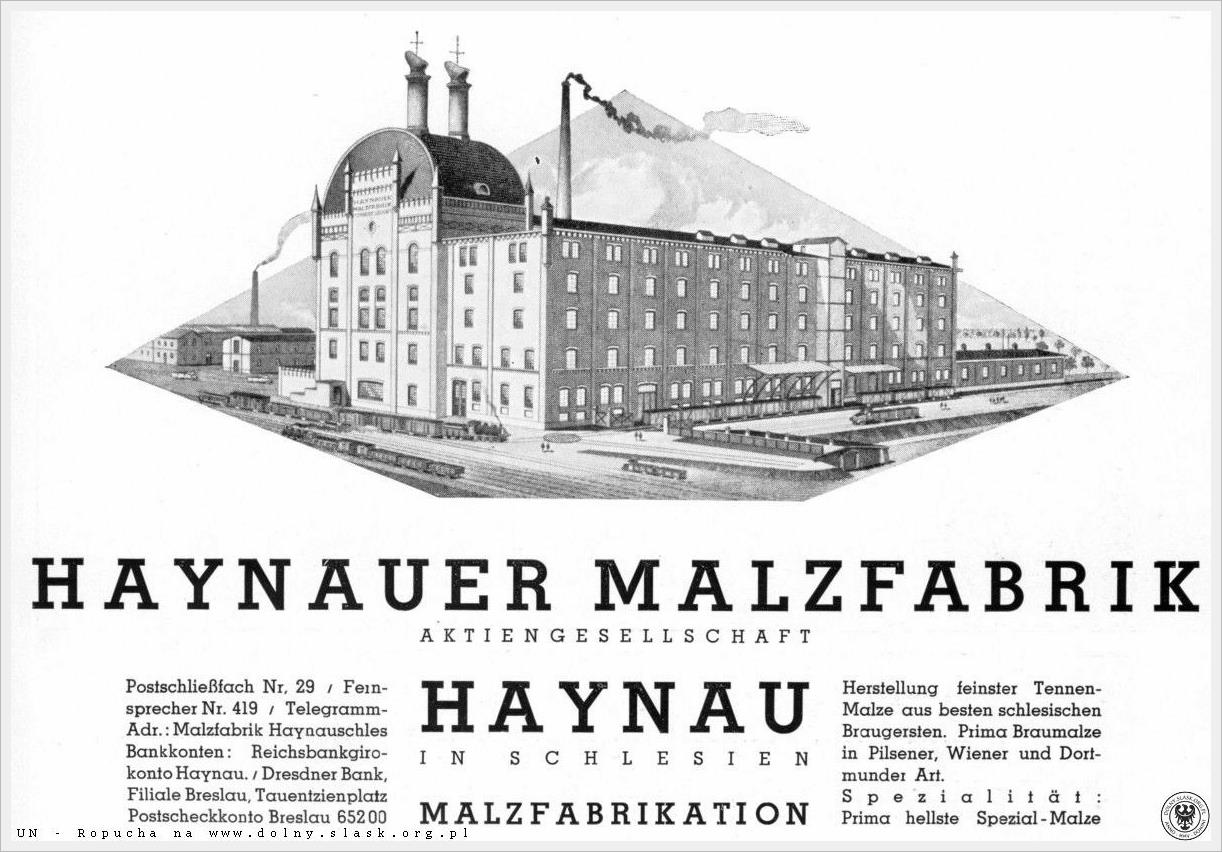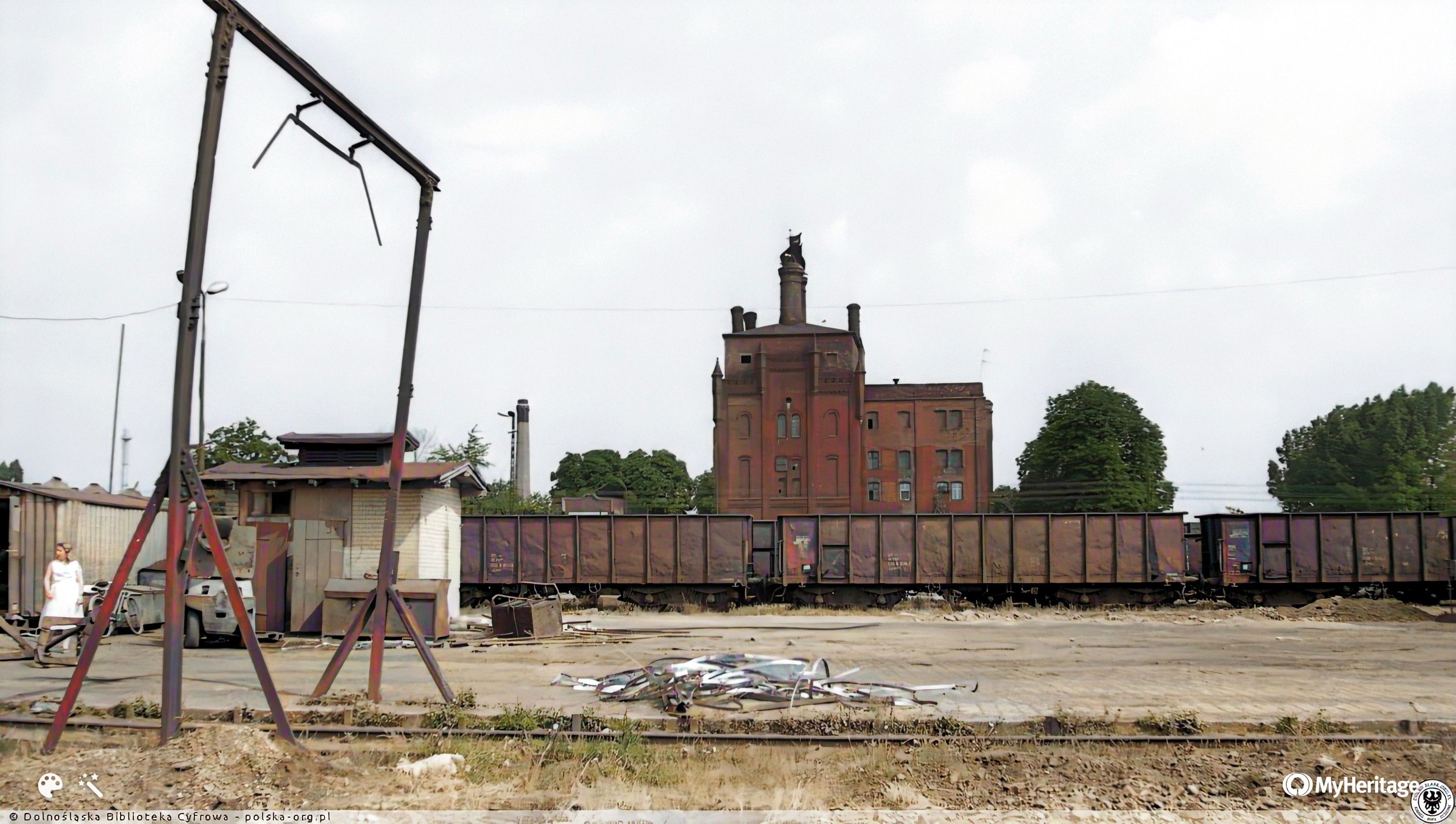[PL] Skrytka to pojemnik PET zawierający logbook i coś do pisania.
[EN] The cache is a PET container containing a logbook and something to write on.

Reklama słodowni / Advertising the malt-house

Widok zza torów stacji w Chojnowie. Data: Czerwiec 1983
View from behind the tracks of the station in Chojnów. Date: June 1983

Słodownia i willa właściciela słodowni Krokera, a obecnie Przedszkole Zgramadzenia Sióstr Służebniczek przy ul. Jarosława Dąbrowskiego 4
Malt-house and villa of the owner of the Kroker malt-house, now the Nursery School of the Servant Sisters at 4 Jarosława Dąbrowskiego St.
[PL]
HISTORIA
Przy ulicy Fabrycznej, naprzeciwko stacji kolejowej, znajdują się ruiny dawnej słodowni, należącej niegdyś do Oswalda Krokera wybudowanej w 1882 roku. Pochodzący z przełomu XIX i XX wieku zakład był bardzo nowoczesny jak na swoje czasy. W dodatku wyróżniał się wspaniałą architekturą. Był kilkukrotnie przebudowywany i modernizowany. Słodownia pierwotnie była samodzielnym przedsiębiorstwem i nie miała nic wspólnego z browarem. W okresie I wojny światowej słodownia była nieczynna, ponieważ została zamieniona w koszary. Ruszyła ponownie dopiero w 1922 roku, a konkretnie dopiero w połowie 1922 roku, po przejęciu przez spółkę akcyjną o nazwie "Haynauer Malzfabrik AG", z kapitałem 2.000.000 Marek. Spółkę założyli inwestorzy z Wrocławia, którzy posiadali akcje o wartości 100.000 Marek. Przetrwała II Wojnę Światową w dobrym stanie. Słodownia funkcjonowała do lat 90. XX wieku. Od czerwca 2011 roku browar zaprzestał produkcji słodu. Potem stal się własnością prywatną, przez pewien czas część jego zabudowań pełniła funkcję mieszkalną. Małżeństwo, które mieszkało w słodowni, wyprowadziło się w styczniu 2012 roku. Od tamtej pory budynek stał pusty. Poszukiwacze złomu znaleźli na miejscu sposób na zarobek. Systematycznie rozkradali wyposażenie, wyrywali okna i drzwi, a gdy w środku zostały już tylko gołe ściany, palnikami acetylenowymi i szlifierkami kątowymi wycinali metalowe elementy konstrukcji. Mieszkańcy Chojnowa niejednokrotnie interweniowali czy to na policji, czy w Urzędzie Miejskim prosząc o lepsze zabezpieczenie starej słodowni. Zamurowane okna i drzwi nie były przeszkodą.
ZAWALENIE SIĘ SŁODOWNI
W dniu 6 sierpnia 2013 roku doszło do tragedii i katastrofy budowlanej. W owym dniu do słodowni weszło 5 złomiarzy. Mieli przy sobie m.in. agregaty prądotwórcze, szlifierki kątowe, ciężki młot z metalowym trzonkiem i przecinaki murarskie. Około 8 rano rozpoczęli pracę na czwartym piętrze budynku. Piętnaście minut później słodownia się zawaliła. Chwilę po zawaleniu się słodowni dwóch złomiarzy zbiegło obawiając się konsekwencji. Dwoje zostało rannych, a ostatni zginą. Jak ustalono, 49-latek, który zginął pod gruzami, niejednokrotnie wcześniej pojawiał się w opuszczonym obiekcie, dokonując jego systematycznej rozbiórki. Jego towarzysze mieli tylko odrobinę więcej szczęścia. 24-latek doznał licznych złamań kości nóg, żeber i kości czaszki oraz kręgosłupa. Przez długi czas miał problemy z chodzeniem. U 28-latka stwierdzono uraz kręgosłupa okolicy lędźwiowej i głowy. Prokuratura zasięgnęła opinii biegłego z zakresu budownictwa. Wynikało z niej, że przyczyną zawalenia się obiektu było usuwanie elementów jego konstrukcji – żelaznych słupów, belek i podciągów przez dłuższy okres czasu.
Osoby, które w dniu zawalenia się budynku w nim pracowały uruchomiły efekt katastrofy, jednakże budynek już wcześniej był doprowadzony do stanu przedawaryjnego przez demontowanie jego konstrukcji przez okres co najmniej pół roku przed katastrofą. Kiedy po usunięciu spod stropu 4 piętra słupów podporowych trzymających konstrukcję weszli nań pokrzywdzeni wnosząc tam dodatkowo urządzenia do rozbiórki, zbrojenie płyty żelbetowej nie utrzymało ich ciężaru i doszło do zawalenia stropu poczynając od piętra IV aż do parteru – streszcza prokurator Liliana Łukasiewicz, rzeczniczka Prokuratury Okręgowej w Legnicy. – Ustaliwszy, że rozbiórki obiektu przez dłuższy czas w różnym zakresie dokonywało wiele osób, nie sposób było przypisać którejkolwiek z nich skutku w postaci zawalenia się budowli i nieumyślnego spowodowania śmierci 49-letniego mężczyzny oraz spowodowania ciężkich obrażeń ciała u dwóch pozostałych.
[EN]
HISTORY
On Fabryczna Street, opposite the railway station, are the ruins of a former malt house, once owned by Oswald Kroker built in 1882. Dating from the turn of the 20th century, the plant was very modern for its time. In addition, it stood out for its magnificent architecture. It was rebuilt and modernised several times. The malt house was originally an independent enterprise and had nothing to do with the brewery. During the First World War, the malt house was closed because it was turned into barracks. It did not start up again until 1922, or more precisely only in the middle of 1922, after it was taken over by a joint stock company called "Haynauer Malzfabrik AG", with a capital of 2,000,000 Marek. The company was founded by investors from Breslau, who held shares worth 100,000 Marks. It survived the Second World War in good condition. The malting plant operated until the 1990s. As of June 2011, the brewery ceased malt production. It then became privately owned, and for a time part of its buildings were used as residential accommodation. The couple who lived in the malt house moved out in January 2012. Since then, the building has stood empty. Scrap collectors found a way to make money on the site. They systematically dismantled the furnishings, ripped out the windows and doors, and when only the bare walls were left inside, they used acetylene burners and angle grinders to cut out metal parts of the structure. The inhabitants of Chojnow intervened more than once, either at the police or at the Town Hall, asking for better security of the old malt house. Bricked-up windows and doors were no obstacle.
COLLAPSE OF A MALT HOUSE
On 6 August 2013, a tragedy and building disaster occurred. On that day, five scrap metal workers entered the malt shop. They were carrying, among other things, power generators, angle grinders, a heavy hammer with a metal handle and masonry chisels. At around 8am, they started work on the fourth floor of the building. Fifteen minutes later, the malt house collapsed. Moments after the malt house collapsed, two of the scrappers ran off fearing the consequences. Two were injured and the last one died. As it was established, the 49-year-old who died under the rubble had appeared at the abandoned building more than once before, carrying out systematic demolition. His companions were only slightly luckier. The 24-year-old suffered multiple fractures to his leg bones, ribs and the bones of his skull and spine. He had difficulty walking for a long time. The 28-year-old was diagnosed with injuries to his lumbar spine and head. The prosecution sought the opinion of an expert in the field of construction. This showed that the cause of the collapse was the removal of elements of the building's structure - iron pillars, beams and uprights - over an extended period of time.
The people who were working in the building on the day of the collapse set in motion the effect of the disaster, however, the building had already been brought to a pre-failure state by the dismantling of its structure over a period of at least six months before the disaster. When, after the support pillars holding the structure had been removed from under the ceiling of the 4th floor, the victims climbed onto it, bringing in additional demolition equipment, the reinforcement of the reinforced concrete slab did not hold their weight and the ceiling collapsed from the 4th floor to the ground floor," summarises prosecutor Liliana Łukasiewicz, spokeswoman for the District Prosecutor's Office in Legnica. - Having established that the demolition of the building had been carried out over a long period of time by a number of people to varying extents, it was impossible to attribute to any one of them the effect of the collapse of the building and the manslaughter of the 49-year-old man and the causing of serious bodily injuries to the other two.